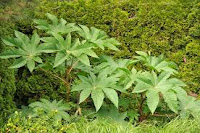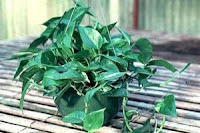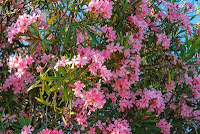Beautifying your home with indoor plants can be extremely enticing and exciting, however for pet owners it can be extremely dangerous due to the fact that your indoor plants may be poisonous to your pet.
At Iz Teremka BRT Kennel, we are very concerned about these indoor plants that we have made a decision not to have any indoor plants in our kennel and house to protect our dogs.
So to contribute to the Black Russian Terrier community and other dog communities, we have compiled a list of poisonous indoor plants for your perusal. Over the years there have been many outdoor trees that have become indoor ornamental trees and some of these trees have been included in our list.
Adenium (Desert Rose)
The Adenium also known as Desert Rose, Desert Azalea Lily, Kudu Lily, Mock Azalea and Sabi Star. Eating any part of this plant can be extremely toxic to your dog. Consult with a veterinarian immediately
Alocasia
Aloe Vera
Aloe Vera also known as Candelabra Plant, Barbados Aloe, Medicine Plant, Octopus Plant, Torch Plant, and True Aloe is a common plant sold in nurseries and hardware stores. This plant Aloes contain anthraquinone glycosides which are laxatives and causes extreme vomiting and diarrhea. Consult with a veterinarian immediately.
Amaryllis (Amaryllis sp.)
Amaryllis also know by common names as Amaryllis, Jersey Lily and Lily Langtry. This plant contains Lycorine, a toxic crystalline alkaloid found in Amaryllis bulbs. If eaten by dogs, it is extremely toxic. Consult with a veterinarian immediately.
Anthurium Scherzerianum (Flamingo Flower)
Anthurium Scherzerianum (Flamingo Flower) is also known by Flamingo Lily, Oilcloth Flower, Painter's Pallet, and Pigtail Plant also exudes Insoluble calcium oxalates which when ingested causes mouth irritation, pain and swelling of mouth, tongue and lips, excessive drooling, vomiting, difficulty swallowing. Consult with a veterinarian immediately.
Arrowhead Plant
Arrowhead Plant contains Insoluble calcium oxalates which causes irritation of the mouth, pain and swelling of the mouth, tongue and lips. Consult with a veterinarian immediately.
Begonia(All)
Begonia is extremely toxic and lethal. Plant contains Cucurbitacin B and Insoluble calcium oxalates. Toxicity of kidneys with renal failure. Consult with a veterinarian immediately.
Brunfelsia
Brunfelsia also known as Fransiscan Rain Tree, Kiss-Me-Quick, Lady-of-the-Night, Today, Tomorrow, Yesterday contains the chemical Brunfelsamidine which causes neurotoxicosis in dogs if ingested. Consult with a veterinarian immediately.
Calla Lily
Calla Lily contain Insoluble calcium oxalates which causes irritation of the mouth, pain and swelling of the mouth, tongue and lips. Consult with a veterinarian immediately.
Castor Bean
Castor Bean also known as African Wonder Tree, Euphorbiaceae, Ricinus, seed, is extremely toxic. Contains glycoprotein called ricin and ricicine, an alkaloid found in both the seeds and leaves. Due to the toxicity of this plant a vet should be consulted immediately.
Cyclamen
Cyclamen also known by the common name of Persian violet, Sowbread contains a very poisonous compound called Terpenoid Saponins which ingested in large quantities can cause heart failure and death. If your pet has ingested any amounts of this plant please consult with your vet immediately.
Dieffenbachia (Dumb Cane)
Dieffenbachia (Dumb Cane) also known as Charming Dieffenbachia, Exotica, Exotica Perfection, Giant Dumb Cane, Spotted Dumb Cane and Tropic Snow contains Insoluble calcium oxalates, proteolytic enzymes. Insoluble calcium oxalates which when ingested causes mouth irritation, pain and swelling of mouth, tongue and lips, excessive drooling, vomiting, difficulty swallowing. Consult with a veterinarian immediately.
Dracaena
Dracaena also known by the common names as Corn Plant, Cornstalk Plant, Dragon Tree, Ribbon Plant contains saponins which when ingested can cause gastrointestinal irritation. If you dog has ingested Dracaena, please consult with your vet.
English Ivy (Hedera helix)
English Ivy also known Branching Ivy, California Ivy, Glacier Ivy, Needlepoint Ivy and Sweetheart Ivy, contains Triterpenoid saponins (hederagenin) which when eaten by a dog causes gastric upset, vomiting, abdominal pain and diarrhea. Please consult with your vet if you suspect that your dog has eaten English Ivy.
Eucalyptus
Eucalyptus and all it varieties contain eucalyptol which is classified as a narcotic and neurotoxin which attacks the kidneys and causes increased salivation, vomiting, diarrhoea, and other symptoms. Consult a vet immediately if your dog has ingested Eucalyptus.
Ficus Benjamina
Ficus Benjamina also known as Weeping Fig, Indian Rubber Plant contains proteolytic enzyme (ficin), psoralen (ficusin). Ficin destroys the dog’s protein cells and Ficusin causes dermatitis and irritability in dogs that may lead to severe scratching which can break the dogs skin leading to serious infections. If you suspect that you dog has eaten the leaves of the bark of Ficus Benjamina, consult with your vet immediately.
Gardenia
Gardenia also known as Cape Jasmine contains the toxins of Genioposide and Gardenoside substances which when ingested by dogs lead to vomiting. diarrhoea. If not treated immediately fatality can occur. Consult with your vet if you suspect that your dog has eaten Gardenia.
Geranium
Gloriosa superba (Flame Lily)
Gloriosa Superba or Gloriosa Lily also known Climbing Lily, Creeping Lily, Fire Lily, Flame Lily, Glory Lily, Superb Lily, Tiger claw is an extremely toxic plant to dogs. The plant contains Colchicine alkaloids. Signs that a dog has ingested the Gloriosa Lily are increased salivation, bloody vomiting, bloody diarrhea, shock, kidney failure, liver damage, bone marrow suppression. Medical intervention is immediately required otherwise fatality will occur.
Golden Pothos
Golden Pothos aliases are Devil's Ivy, Ivy Arum Pothos and Taro Vine contain Insoluble calcium oxalates which causes irritation of the mouth, pain and swelling of the mouth, tongue and lips. Consult with a veterinarian immediately.
Jade Plant
Jade Plant also known as Baby Jade, Chinese Rubber Plant, Dwarf Rubber Plant, Jade Tree, Japanese Rubber Plant contains unknown toxins, however dogs that have ingested this plant have shown signs of depression, incoordination and vomiting. As there are unknown toxins, a dog that has ingested the Jade Plant should seek immediate attention from a vet.
Kafir Lily
Kafir Lily also known by the names of Clivia Lily and Clivia Minata contains Lycorine and other alkaloids. Lycorine Lycorine is a toxic crystalline alkaloid found in various Amaryllidaceae species, such as the cultivated bush lily (Clivia miniata), surprise lilies (Lycoris), and daffodils (Narcissus). It may be highly poisonous, or even lethal, when ingested in certain quantities.
Clinical Signs: Vomiting, salvation, diarrhea; large ingestions cause convulsions, low blood pressure, tremors and cardiac arrhythmias. Bulbs are the most poisonous part.
If your dog has ingested this plant see immediate vet attention.
Kalanchoe
Kalanchoe also known as Chandelier Plant, Devils Backbone, Mother-In-Law-Plant and Mother of Millions contain the chemical compound Bufodienolide which is a cardiac glycoside. The clinical signs of ingestion is Vomiting, diarrhea, abnormal heart rhythm (rare). If your dog has ingested, seek medical attention from a vet.
Mistletoe
Oleander (Nerium)
Nerium oleander contains cardiac glycosides which causes hyperkalemia. Clinical signs of ingestion could be Arrhythmias, Blood pressure changes , Dehydration, Gastrointestinal (vomiting, diarrhea), Neurological signs (lethargy, depression, ataxia, tremors, seizures) and Shock. Immediate vet intervention is required.
Peyote (Lophophora williamsii)
Peyote (Lophophora williamsii) contains the hallucinogen mescaline, the effects which is similar to LSD. If your dog has ingested this, immediate attention is a must.
Philodendron (Heartleaf)
Philodendron (Heartleaf) also known by Cordatum, Fiddle-Leaf, Fruit Salad Plant, Horsehead Philodendron, Panda Plant, Red Emerald, Red Princess, Saddle Leaf, and Split Leaf Philodendron contain Insoluble calcium oxalates which causes irritation of the mouth, pain and swelling of the mouth, tongue and lips. Consult with a veterinarian immediately.
Poinsettia
Poinsettia contains a sap that is an irritant to the dogs mouth and stomach. Seek the help of a vet.
Prayer Bean
Prayer Bean is also known as Buddhist Rosary Bead, Indian Bead, Indian Licorice, Love Bean, Lucky Bean, Rosary Pea, Precatory Bean, Rosary Pea, Seminole Bead and Weather Plant contains Abrin and Abric Acid a glycoside. Clinical symptoms of Prayer Bean ingestion includes severe vomiting and diarrhea (sometimes bloody), tremors, high heart rate, fever, shock, death. Seeds are very toxic (seed coat must be broken). Vet intervention is a must.
Sago Palm
Sago Palm is all known as Cardboard Palm, Coontie Palm, Cycads and Zamias contains Cycasin which is a carcinogen. Ingestion results in clinical symptoms of bruising, coagulopathy, death, hemorrhagic gastroenteritis, icterus, increased thirst, liver damage, liver failure and vomiting. If you suspect that you dog has eaten any part of the Sago Palm, seek the advice of a vet.
Schefflera
Schefflera also known as Australian Ivy Palm, Octopus Tree, Starleaf and Umbrella Tree contains Insoluble calcium oxalates which causes irritation of the mouth, pain and swelling of the mouth, tongue and lips. Consult with a veterinarian immediately.
Spathiphyllum (Peace Lily)
Strelitzia (Bird of Paradise)
Strelitzia (Bird of Paradise Flower)(Do not confuse with Caesalpinia or Poinciana Gilliesii, which is also known as Bird of Paradise and is more toxic.) also known as Bird's Tongue Flower and Crane Flower contain GI irritants. Ingestion results in Mild nausea, vomiting, drowsiness; caused mainly by fruit and seeds.
Ti plant (Cordyline terminalis)
Ti plant (Cordyline terminalis) is also known by Baby Doll Ti Plant, Hawaiian Ti Plant contains Saponins which when ingested produces anorexia, depression, hypersalivation and vomitus with blood. If you dog has ingested the Ti plant seek the aid of a vet.









































